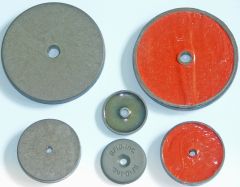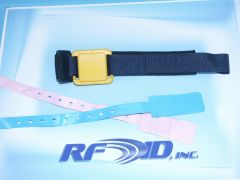CNC / Tooling / Molds
In CNC applications, RFID provides a solution to ensure the right tooling is in place before a process is allowed to begin. Molds have a finite life and RFID sensing provides a method to track which mold is nearing its end of life or which mold is brand new but producing rejected products at a 30% rate.
RFID Frequency options:
There are, with some exceptions, 3 main RFID frequencies to consider when deciding which to best implement according to the application specifics and requirements.
1. 125 KHz LF (low frequency) short-range passive RFID Tags.
LF can be out of the box metal friendly offering RFID Tags that can be mounted on or in metal without the need for additional backings or protection. It can be relied upon to not exceed an exacting range requirement thus ensuring the intended RFID Tag is read.
2. 13.56 MHz HF (high frequency) short-range passive RFID Tags.
While not as metal friendly without the need for additional backings, HF Tags generally slightly less expensive in basic forms, like labels. HF Tags can also be supplied as a label, important when disposable Tags are necessary. As a general rule, HF Tags cannot be subsurface mounted into metals or in metal intensive environments. HF can be relied upon to not exceed an exacting range requirement thus ensuring the intended RFID Tag is read.
3. 902-928 MHz UHF (ultrahigh frequency) long-range passive RFID Tags.
Certain UHF RFID Tags can be metal mountable and subsurface metal mounted. Those include Tags made of an FR4 material, ceramic material, or labels with a ferrous backing. UHF can provide read ranges measured in feet for smaller Tags and up to 10 meters with larger Tags. They can also be supplied as a label as the RFID industry’s most cost-effective disposable RFID Tag. An additional benefit is that UHF Tags can be read en masse, up to hundreds at a time, known in the RFID industry as anti-collision.
Case Studies by Applications
Molds for Mannequins
 LF Reader Antenna
LF Reader AntennaThe expanding foam substance used to shoot mannequin parts is caustic and can cause injury. Molds are broken down into body pieces, torso, hand, head, arms, feet, legs. The goal is to avoid shooting enough material for a torso into a mold that is intended for a hand or foot. In an effort to take the decision making away from mistake prone humans, each mold has an RFID Tag, which when read advises a PLC how much of the foam to shoot into the mold cavity. The employee need only pull a trigger. This method prevents:
- Loss of raw materials.
- Employee injury.
- Hazardous materials cleanup and OSHA reports.
- Downtime.
This particular application was fitted with 125 KHz LF (low frequency) RFID Tags due to its metal friendly capabilities and limited read range. 13.56 MHz HF (high frequency) RFID Tags could have been installed however additional backings to the Tags would have been necessary in order to be metal mountable. 915 MHz UHF (ultrahigh frequency) long range RFID Tags were not installed to avoid the circumstance of reading an incorrect Mold/Tag some feet or meters from the intended target.
Molds for Razor Manufacturing
A large operation may have hundreds of plastic injection molds. Molds have a finite life. Which is mold nearing its maximum yield? Which mold is brand new yet QC feedback shows a 40% fallout rate?
RFID Tags applied to molds provide management with the information needed to answer the questions above. Mold usage data can be held on the RFID Tag or offline in an MES (manufacturing execution system). RFID Tags applied to molds hold benefits of:
- Uniquely identifying each mold.
- Prevents the loss of line time, manufacturing time.
- Prevents the loss of raw materials used in producing bad product.
- Increase in productivity.
In the photos shown below, this particular application was fitted with 125 KHz LF (low frequency) RFID Tags due to their metal friendly capabilities and limited read range. Admittedly the RFID Tags shown is large and could be much smaller, sleeker today, as these application photos are from 1990, although the solution has not changed and the product has been supported for 30 years. Both 13.56 MHz HF (high frequency) and 915 MHz UHF (ultrahigh frequency) had not yet been invented however the same issues of metal and excessive read range would have factored in LF being the technology of choice.
Molds for Casting Engine Blocks
 The LF Tag with proprietary high temp fill:
The LF Tag with proprietary high temp fill: The UHF FR4 high temperature RFID Tag:
The UHF FR4 high temperature RFID Tag:Heat often plays a factor in molding operations as can be viewed from these application photos of sand casting engine blocks. The application needs herein were not for tracking of each individual mold, yet the actual widget itself through varying manufacturing steps. While the RFID Tags shown below are rated only for 250°C, RFID Inc. offers Tags to as high as 550°C. This method prevents:
- Track widgets through manufacturing process.
- Identify varying models of widgets at manufacturing stations for process control.
- Provides data integral to MES planning for materials and product output.
Although originally installed with 125 KHz LF (low frequency) RFID Tags this project was later updated to UHF 902-928 MHz due to line changes and the need to read Tags mounted on power & free overhead conveyor with hanging pallets at 1 meter to 7 meters distance.
Verify Correct Tool - Exhaust Pipe Manufacturing
 LF Tag
LF Tag LF Reader Antenna
LF Reader AntennaThere can be several sections to automobile exhaust pipes, all requiring different bends depending upon different automobiles. Some are bent 90 degrees, some 70 degrees, some only slightly. Bending pipe requires a softer metal on a flexible axis at the bend point. Using a harder metal will result in the pipe breaking. Notice the soft copper donuts at the end of the mandrel. What can be viewed in the photos is a machine with a mandrel that extends to predetermined distances after an assembly employee threads the pipe over the mandrel. The machine will go into action bending the pipe by applying pressure left or right. After each bend, the mandrel will push the pipe forward and then retract for a subsequent bend. The degree of those bends will determine how many soft copper donuts are on the mandrel end, and it is important to know once a pipe has finished if the donuts have broken off and remain in the pipe. The use of RFID Tags assists with:
- Verify the correct tool is in place (number of soft copper donuts and diameter of donuts).
- Verify if a donut has broken off into the pipe to prevent issues for the automobile after sale.
- If the donut has broken off, stop all machine activity as next bend will break the pipe.
Given the large amount of metal present, a 125 KHz Tag LF (low frequency) RFID Tag is applied to the last donut on the tool. Notice the Reader is capable of reading around blocking metal and into the mandrel channel. Obviously the machine, through a PLC or some other logic device, is given a recipe to determine bend ratios, lengths between bends, but will not allow the machine to start without first verifying a tool is in place, and whether or not it is the correct tool. Keep in mind this machine is so fast that a pipe with 3 bends is finished in 3 seconds.
CNC Machining with Tags Flush Mounted into Metal
 Tag
Tag LF Reader Antenna
LF Reader AntennaIn the world of CNC applications, one of the biggest mistakes made is the incorrect tool or jig in place before a procedure begins. Imagine a lathe spinning with the widget to be tooled. Once a piece of metal or Teflon or UHMW is cut or honed done into shape, it can’t be undone.
The expanding foam substance used to shoot mannequin parts is caustic and can cause injury. Molds are broken down into body pieces, torso, hand, head, arms, feet, legs. The goal is to avoid shooting enough material for a torso into a mold that is intended for a hand or foot. In an effort to take the decision making away from mistake prone humans, each mold has an RFID Tag, which when read advises a PLC how much of the foam to shoot into the mold cavity. The employee need only pull a trigger. This method prevents:
- Loss of raw materials.
- Loss of machine and manufacturing time.
Notice RFID Tags are small, and, in order to be unobtrusive, are subsurface mounted into the tools with both 125 KHz LF (low frequency) Tags for ranges of 1 inch and 915 MHz UHF (ultrahigh frequency) long range RFID Tags for ranges of 3 inches to several feet.
-
 LF High Temperature RFID Tags
LF High Temperature RFID TagsHigh Temperature 125 KHz RFID Tags are typically applied to paint curing oven applications or other high temperature processes found on the factory floor or in an industrial identification setting.
View Product -
 LF Plastic Wedge - Coffin RFID Tag
LF Plastic Wedge - Coffin RFID TagKnown as the RFID brick tag, plastic wedge and/or coffin tags due to its unique shape, the brick tag excels in applications requiring a small foot print as they can be embedded in space-restricted applications. Brick tags also offer great durability as they can withstand physical stress and are resistant to water, chemicals, acids, and temperature extremes. Brick tags can also be mounted on or in metal.
Brick Tag Applications
- Cable identification
- Tool or weapon inventory
- Surgical instrumentation tracking
- Medical equipment status and utilization
-
 LF Glass Ampoule RFID Tags
LF Glass Ampoule RFID TagsThese Glass Ampoule RFID LF 125 KHz Tags are used in opportunities requiring a small footprint and excel when mounted in or on metal.
View Product -
 UHF 915 MHz Ceramic RFID Tags
UHF 915 MHz Ceramic RFID TagsCeramic UHF 915 MHz RFID tags offer metal mount ability as well as elevated temperature specifications. Ceramic RFID tags are also heat, water, and chemical resistant.
Ceramic RFID Tag Applications
- Electrical components for automotive industry such as board and parts management
- Surgical management and medical devices for medical industry
- Tool management for industrial and manufacturing
-
 UHF 915 MHz RFID Patient Style Wristbands
UHF 915 MHz RFID Patient Style WristbandsRFID Wristband Tags are used for employee identification, typically for machinery control as well as medical patient identification and tracking.
View Product -
 UHF Model S4 Series RFID Readers
UHF Model S4 Series RFID ReadersThis Reader ports up to 4 addressable RFID Antennas with USB and Serial communications standard on all models, and further offer standard Ethernet, Profinet, Profibus, Ethernet/IP, Devicenet, Modbus TCP & RTU. Two lines of I/O are also standard. This Reader can also write to RFID Tags and has a range tuning feature.
View Product -
 Model F1004 FR4 Tag, Mount on Metal High Temperature 200C, 10x4mm, UHF 902-928 MHz passive RFID
Model F1004 FR4 Tag, Mount on Metal High Temperature 200C, 10x4mm, UHF 902-928 MHz passive RFIDModel F1004 FR4 Tag, Mount on Metal High Temperature 200C, 10x4mm, UHF 902-928 MHz passive RFID
View Product -
 Model PBT1438 ABS Bolt Tag, orange, 14mm diameter x 38mm length, UHF 902-928 MHz passive RFID
Model PBT1438 ABS Bolt Tag, orange, 14mm diameter x 38mm length, UHF 902-928 MHz passive RFIDModel PBT1438 ABS Bolt Tag, orange, 14mm diameter x 38mm length, UHF 902-928 MHz passive RFID
View Product -
 High Temperature RFID Tags - 148 KHz
High Temperature RFID Tags - 148 KHzHigh Temperature 148 KHz RFID Tags are typically applied to paint curing oven applications or other high temperature processes found on the factory floor or in an industrial identification setting.
View Product



